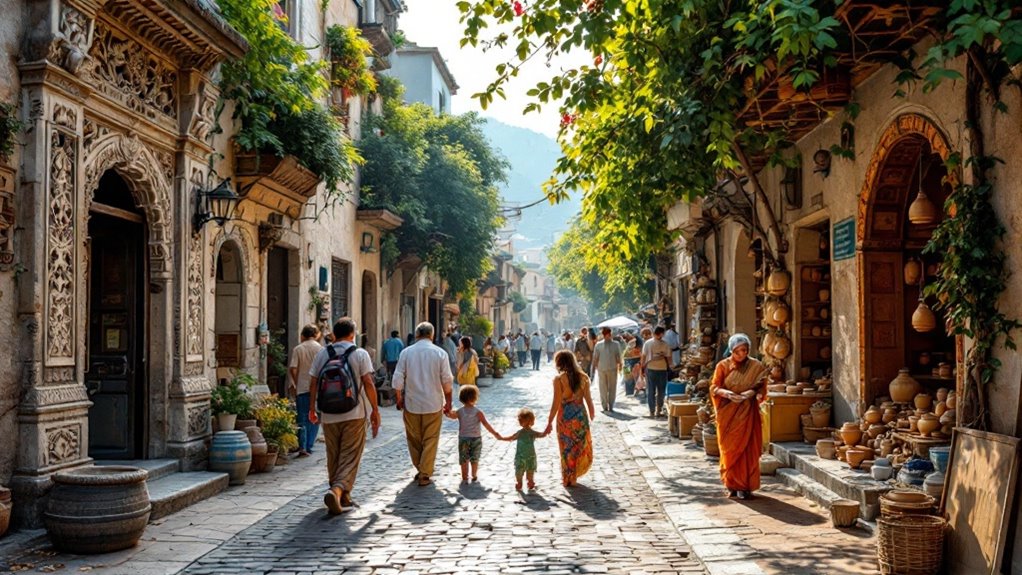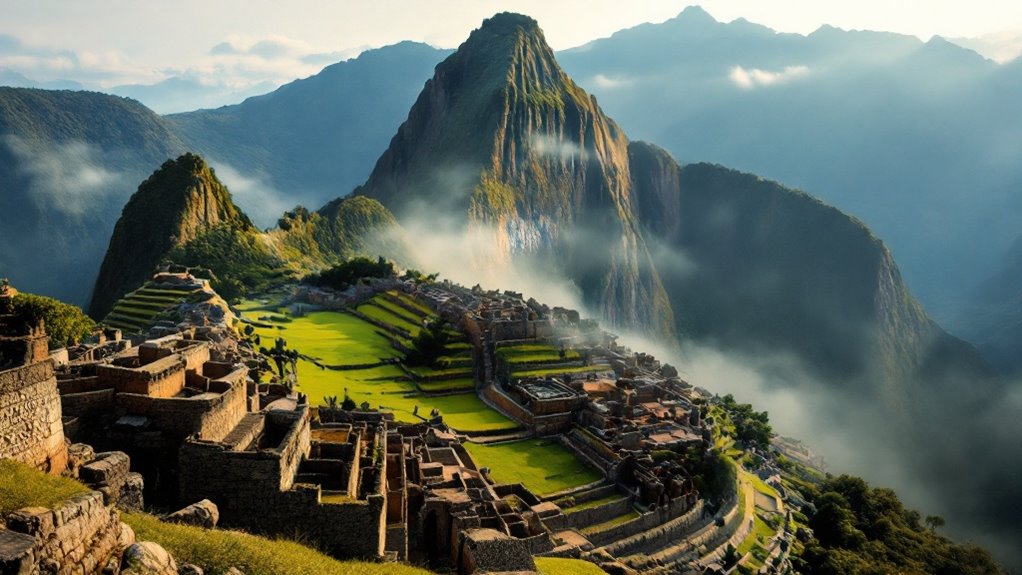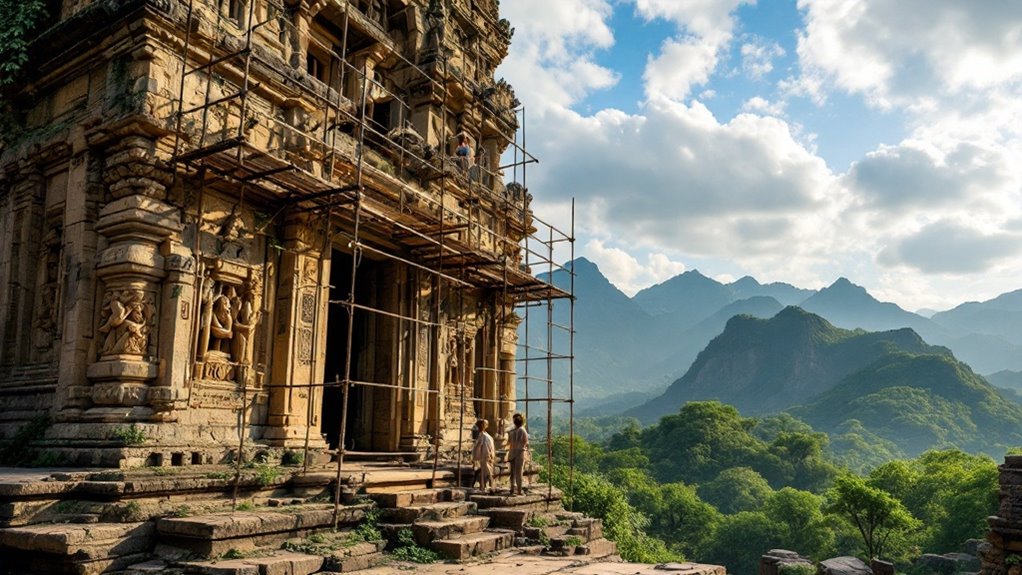When you write about UNESCO World Heritage Sites, you want to avoid sounding like you're rattling off a list of facts. Instead, think about how you can weave in storytelling and striking imagery. Picture the cool breeze whispering through the ancient ruins or the lively hues of a bustling market nearby. It's not merely about what you see but how you connect with the place. Consider the stories of those who live there, their history, and how these sites shape their identities. But how do you balance informative content with engaging narratives? That's where the real challenge lies.
Embrace Storytelling Techniques
Storytelling techniques can transform how one experiences UNESCO World Heritage Sites, making them come alive in ways you never anticipated. Picture standing in front of an ancient monument, not just seeing it but exploring its history through digital narratives. With tools like 3D models and interactive maps, one can dive deep into the past and uncover stories once hidden in time. These technologies enhance understanding and foster community engagement, since people from all walks of life can access and contribute to these digital tales. The use of locative media connects narratives with specific locations, allowing visitors to engage with the heritage sites on a deeper level. Virtual Reality (VR), Augmented Reality (AR), and Mixed Reality (MR) enable individuals to walk through history, connecting with cultures in a way that's both immersive and personal. One isn't just a passive observer; one becomes part of the story, an active participant in cultural preservation. Multimedia content, like audio-visual materials, serves as a guide, filling the gaps of traditional storytelling. Wearable guides and context-aware games make the experience interactive and fun, allowing individuals to learn while they play.
Through engaging digital exhibitions, one can explore these heritage sites remotely, making world travel unnecessary. So, get ready to adopt storytelling techniques that make history feel like a futuristic adventure!
Use Descriptive Imagery
Visualize standing before a UNESCO World Heritage Site, where storytelling techniques have already set the scene, and now descriptive imagery paints the picture. Conceive the intricate Baroque and Rococo curves of the Sanctuary of Bom Jesus de Matosinhos in Brazil, each swirl of stone telling a tale of artistry and devotion. While you walk along the hexagonal basalt blocks at the Giant's Causeway in the UK, their geometric precision and rugged beauty captivate your senses. The ancient stones of Stonehenge whisper secrets of a 5000-year-old past, their weathered surfaces bearing witness to millennia of mystery. Just as satellite imagery has been crucial for assessing damage to cultural heritage sites, it is equally important for proactive heritage site management to ensure these wonders are preserved for future generations.
Feel the cool, textured wood and stone of Diamantina's Historic Centre in Brazil under your fingertips, a reflection of the craftsmanship of eras gone by. The Jurassic Coast's rock formations in the UK display nature's artistry, sculpted by time and tides, revealing the earth's ancient history. Picture Rio de Janeiro's lush landscapes, where mountains meet the sea, and lively ecosystems thrive in a kaleidoscope of life.
Descriptive imagery transforms facts into a striking narrative, engaging your senses with each detail. With these tools, you'll transport readers to these wondrous sites, making history and nature come alive.
Focus on Local Perspectives

When you visit a UNESCO World Heritage Site, it's crucial to contemplate the perspectives of the local community that calls it home. Community engagement isn't just a buzzword—it's a fundamental piece of sustainable tourism. By talking with local businesses and residents, you can gain insights into their aspirations and challenges. It's like having a backstage pass to the real show, beyond the guidebooks. Regularly monitoring and reporting the community's views helps guarantee that development doesn't go off the rails. Building respect and trust between conservation efforts and local communities enhances visitor experience.
Local narratives add a rich layer to your understanding of the site. Envision telling a story that combines the UNESCO spotlight with the lively tales of the local culture. It's like mixing chocolate and peanut butter—a match made in heaven! Working with schools and educational groups, you can help bring the community's story to life, making sure indigenous perspectives aren't left out.
Empowering locals through education and capacity building is another critical step. By supporting community-based management, you can help locals take charge of tourism. So go ahead, plunge into the local perspectives and let their stories transform your visit from ordinary to extraordinary.
Highlight Lesser-Known Facts
You've explored the lively narratives of local communities, and now it's time to uncover lesser-known facts about these UNESCO World Heritage Sites. Envision Mammoth Cave National Park, not just as a massive network of tunnels, but as a hidden gem where underground lakes defy gravity, creating unexpected connections to a world of stalactites and stalagmites. Meanwhile, Madagascar's Tsingy de Bemaraha boasts limestone formations that seem borrowed from a sci-fi movie—a sharp, ancient landscape almost 200 million years in the making.
Over in Russia, the Volcanoes of Kamchatka don't just smoke and smolder; they host a thriving ecosystem where sea eagles and otters roam, proving nature's adaptability in the most unexpected ways. Canada's Dinosaur Provincial Park is a fossil treasure trove, where the earth's layers whisper tales of prehistoric giants waiting to be unearthed. In Peru, Machu Picchu remains a marvel not only for its breathtaking setting but also for its mysterious construction that continues to puzzle historians and archaeologists alike.
Switching gears to Ha Long Bay, Vietnam, you find a watery maze of around 2,000 islands and islets. Each turn might reveal a secret cave or a secluded lagoon, inviting you to ponder the bay's unique dance between land and sea. So, dive deeper—there's always more than meets the eye!
Discuss Cultural Significance

Though often admired for their beauty and grandeur, UNESCO World Heritage Sites hold a deeper cultural significance that transcends their physical appearance. These sites are not just eye candy; they're the backbone of our cultural identity and historical legacy. Envision the Pyramids of Egypt or the Baroque cathedrals of Latin America—not just architectural marvels, but masterpieces of human creative genius. They showcase the exceptional skill and innovation of their time, becoming symbols of the cultures and civilizations they represent. UNESCO's designation involves a stringent selection process, ensuring that these sites are recognized for their exceptional cultural and historical significance. Think of ancient ruins or traditional human settlements. They offer a snapshot into past lives, revealing how extinct or living cultures have thrived and interacted. Sites like Angkor or the Old City of Dubrovnik serve as time machines, transporting you back to different eras, providing valuable insights into our shared human story.
And let's not forget places like the Wieliczka Salt Mine or the Ngorongoro Conservation Area—they're more than just tourist spots; they're chapters in the book of human history. These sites illustrate significant stages in architecture, technology, and town-planning. So next time you're exploring one, remember—you're walking through pages of our collective past.
Incorporate Personal Experiences
Stepping into a UNESCO World Heritage Site often feels like entering a living storybook, where every corner has a tale to tell. These sites aren't just about ticking off a travel bucket list—they're about emotional resonance and sensory immersion. Envision standing at the edge of Petra's red sandstone cliffs, feeling the wind whisper ancient secrets. You're not just seeing; you're experiencing. The sound of the wind through the Siq or the splash of rain at Machu Picchu makes everything feel so alive.
Your journey becomes personal, like tasting rustic Tuscan cuisine, each bite a story of generations. And let's not forget the goosebumps at sunrise over Mount Sinai, a moment of personal reflection that often leaves you in awe. It's these emotional connections that turn a visit into a vivid memory. Visiting the Taj Mahal in India, with its stunning white marble façade, you can feel the cultural significance of the world's largest and most expensive love gift.
The encounters with local cultures, like the warm hospitality of Bedouin tribes or the historical weight of Mostar's Old Bridge, enrich your understanding. While you explore, these experiences weave together, creating a fabric of memories that's uniquely yours. By sharing your personal experiences, you invite others to feel the heartbeat of these extraordinary places.
Address Conservation Challenges

Against the backdrop of breathtaking beauty and historical significance, UNESCO World Heritage sites face pressing conservation challenges. You might picture these sites as untouchable treasures, but they're under constant threat from human activities and environmental changes. Mining, oil projects, and urbanization are just a few culprits. Picture the Historic Town of Zabid in Yemen, where concrete jungles have replaced 40% of its original houses. It's a classic case of unchecked tourist development leading to pollution and overcrowding.
Conservation strategies should be at the forefront of your mind when discussing these sites. It's essential to address the impact of deforestation and pollution, like the wastewater from Baikal Pulp and Paper Mill threatening Lake Baikal. Community involvement plays a key role here; engaging locals can lead to better management and sustainable practices. Think of climate change as a never-ending villain affecting every fourth site, from coral reefs to glaciers. A significant number of World Heritage Sites are threatened by mining and oil/gas projects, reinforcing the need for proactive conservation measures.
Armed conflicts add another layer of complexity. Sites often become collateral damage in wars, while illicit trafficking erodes biodiversity. Financial constraints and poor management further exacerbate these issues. By highlighting these challenges, you're not just writing; you're advocating for global heritage conservation.
Engage With Interactive Elements
In the domain of UNESCO World Heritage sites, interactive elements provide a dynamic way to explore and understand these precious locations. You can immerse yourself in the World Heritage Online Map Platform (WHOMP) and discover sites like never before. With interactive maps, you can see color-coded conservation statuses, filter by country or year, and even measure distances. It's like a treasure map, but instead of gold, you find cultural gems. WHOMP integrates with UNESCO databases, ensuring what you see is accurate and up-to-date. Maps are available in English, French, and Spanish, so language barriers won't stop your virtual exploration. UNESCO also focuses on safeguarding Intangible Cultural Heritage through visualizations, making it easier to understand connections between cultural elements and regions.
If you're into 3D and virtual reality, the "Engage with Heritage" platform is your playground. Envision standing in the middle of Bahla Fort, all from your couch! This platform lets you explore World Heritage sites in 3D, using virtual reality, augmented reality, and more. It's perfect for education, safeguarding, or just impressing your friends with your newfound historical knowledge. Plus, it comes with cool features like geolocated narratives and 3D video animations.
Wrapping up
You've got the tools now, so envision standing at the edge of a World Heritage Site, feeling the whispers of ancient winds. It's more than just about facts; it's about capturing the soul of a place. Think of those local tales and the lively colors that dance around you. The journey is about weaving these stories together, making readers feel the heartbeat of history. So, are you ready to transform your writing from brochure to enthralling journey?